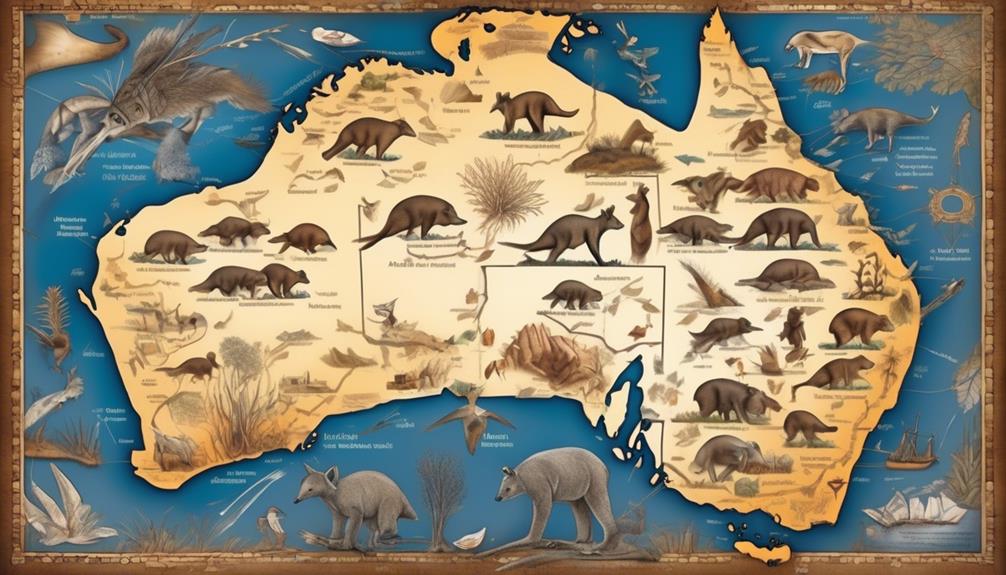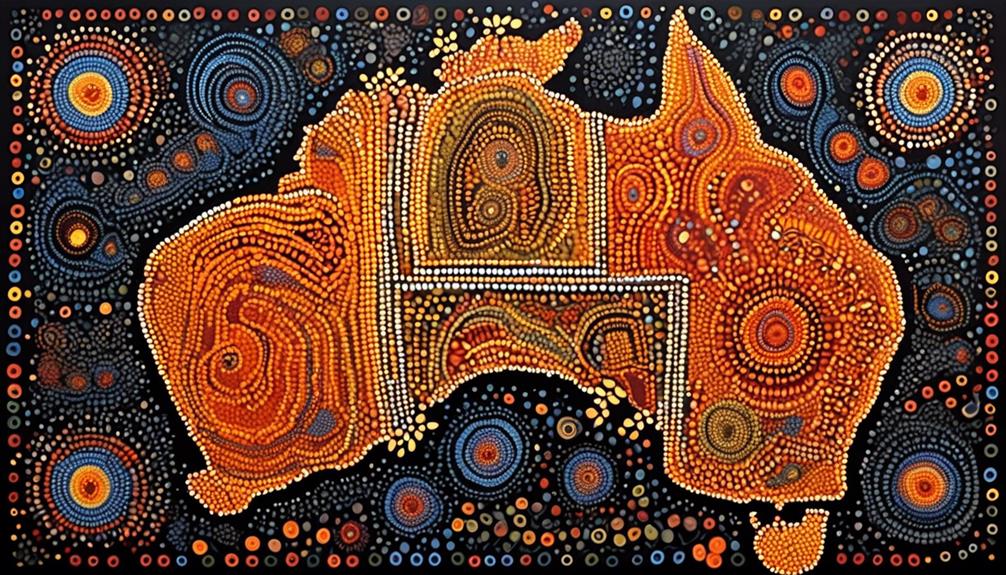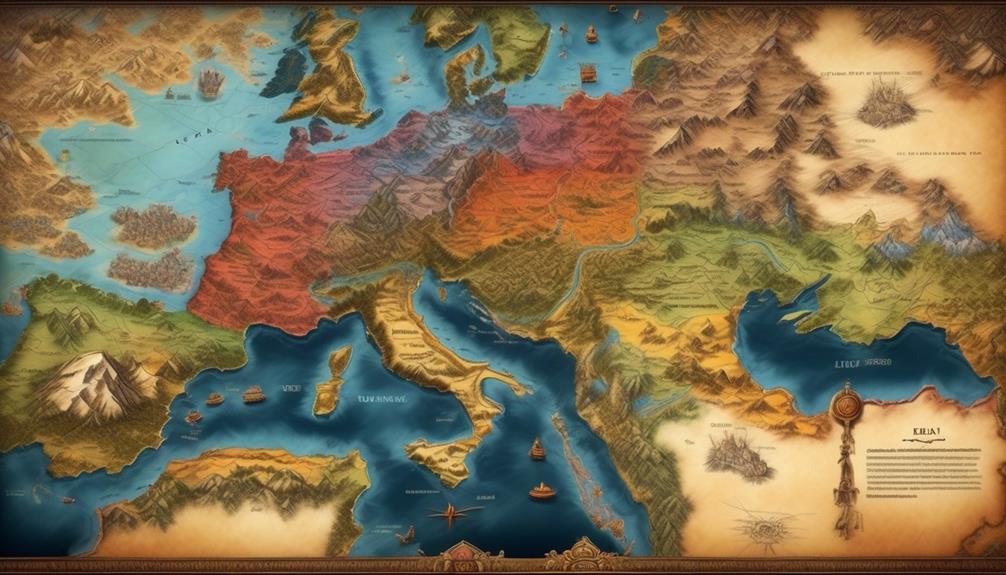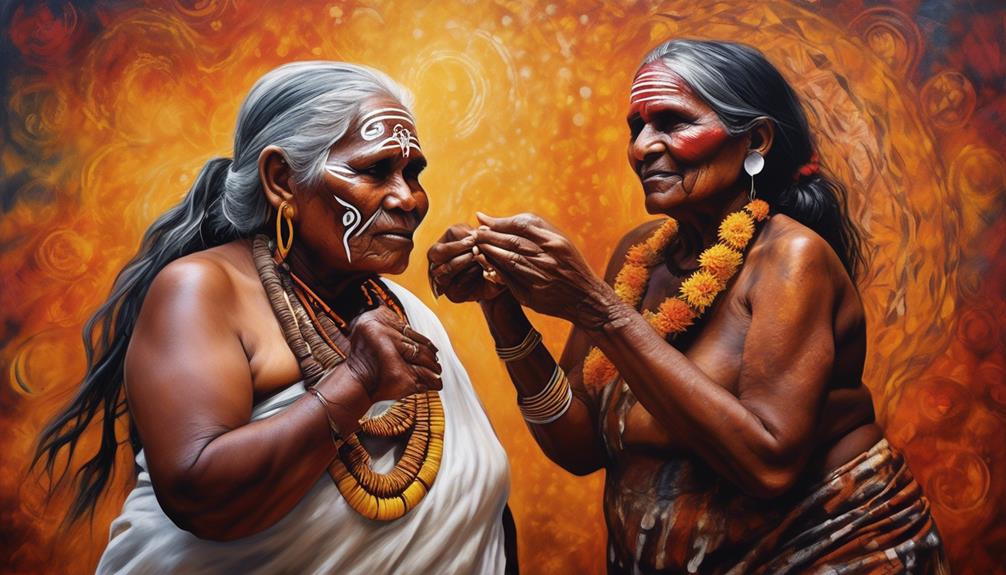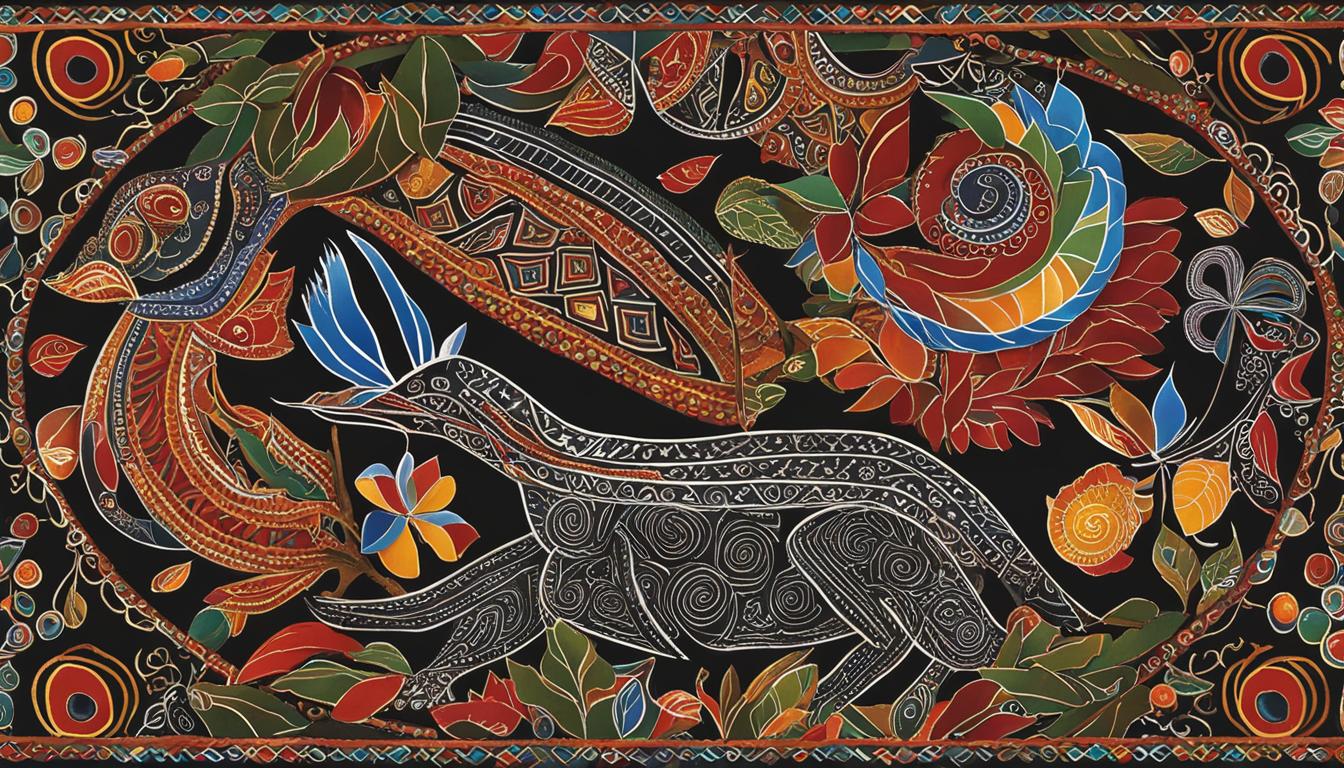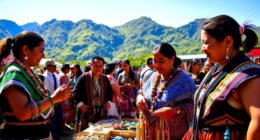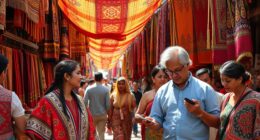While surrounded by the vast and historic landscapes of Australia, one can’t help but wonder about the origins of the country’s Aboriginal people.
Throughout history, there have been various theories and studies attempting to unravel the mystery of their arrival on this continent. From ancient genetic lineages to migration patterns and archeological discoveries, the quest to understand the roots of Australia's Indigenous people has led to intriguing findings and compelling narratives.
Join us as we explore the complex web of evidence and stories that offer insights into the rich and diverse origins of Australia's Aboriginal population.
Key Takeaways
- Aboriginal genetic lineage dates back over 50,000 years, making it one of the oldest continuous cultures on Earth.
- There is a single major wave of expansion from Africa that led to the peopling of Australia.
- Coastal migration and inland dispersal routes have shaped the diverse societies of Australia's Aboriginal population.
- Archaeological discoveries provide insights into migration patterns, genetic evidence, and cultural connections among Aboriginal groups.
Ancient Genetic Lineage
The ancient genetic lineage of Australia's Aboriginal population provides vital insights into their ancestral origins, migration patterns, and cultural connections with neighboring populations. Through genetic diversity studies, we've uncovered the deep ancestral connections of Australia's Aboriginal population, shedding light on their migration routes and the relationships with other indigenous groups. Genetic research has revealed a remarkable continuity of the Aboriginal genetic lineage, dating back over 50,000 years, making it one of the oldest continuous cultures on Earth.
By analyzing the genetic diversity within the Aboriginal population, scientists have been able to trace their origins to the earliest human migrations out of Africa. This research has highlighted the significant contributions of the Aboriginal population to the understanding of human evolutionary history. Moreover, it has provided evidence of the complex and diverse ancestral connections between different Aboriginal groups, shaping the rich tapestry of their cultural heritage.
The study of ancient genetic lineages has also uncovered the intricate web of connections between the Aboriginal population and neighboring indigenous groups, such as the Melanesian and Papuan peoples. This hasn't only enhanced our understanding of the historical interactions between these populations but has also emphasized the shared ancestry and cultural exchanges that have occurred over millennia.
Migration Patterns
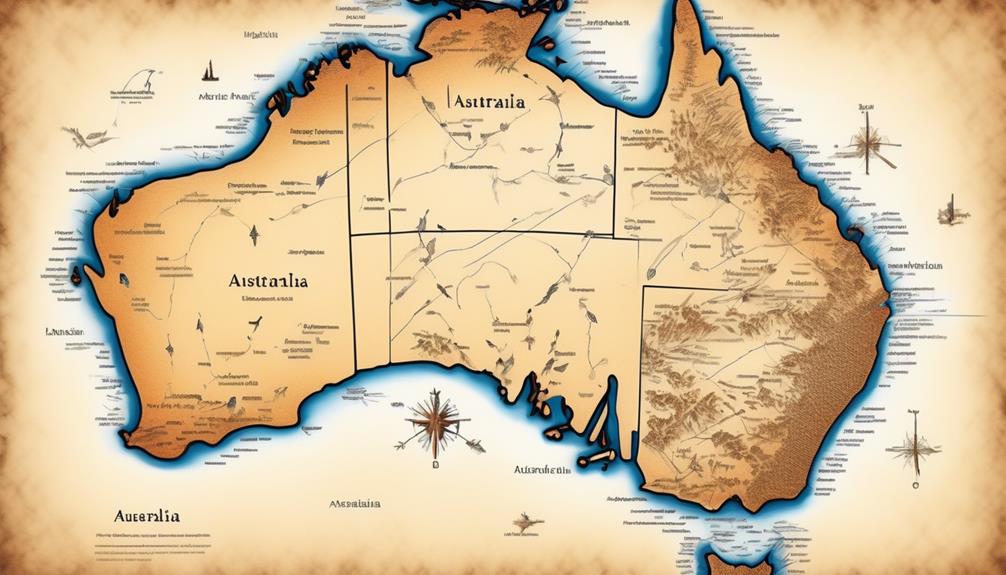
Our understanding of the migration patterns of Australia's Aboriginal population is crucial in comprehending their rich history and cultural development.
Early coastal migration and inland dispersal routes played a significant role in shaping the diverse and complex societies that emerged across the continent.
Early Coastal Migration
Having traveled along the coastal regions, early Aboriginal populations established migration patterns that were integral to their survival and cultural development.
Coastal settlements provided abundant marine resources, shaping the lifestyle and movement of these communities. The proximity to the coast allowed for a reliance on fishing, shellfish gathering, and other marine food sources, which influenced the seasonal movements of these early populations.
The migration patterns weren't only driven by the quest for sustenance but also by the need to maintain social connections and trade networks with neighboring groups. These coastal migrations facilitated the exchange of cultural practices, technologies, and social interactions, contributing to the rich diversity and adaptability of the Aboriginal people.
The movement along the coastlines also allowed for the exploration and utilization of different ecological zones, further enhancing the resilience and resourcefulness of these early communities.
Inland Dispersal Routes
Exploring beyond the coastal regions, our ancestors sought new routes and opportunities for sustenance and cultural exchange, shaping the inland dispersal routes and migration patterns of Australia's early Aboriginal populations.
The inland migration of Australia's Indigenous origins was a complex process, influenced by environmental factors, resource availability, and social dynamics.
As our ancestors ventured into the inland regions, they adapted to diverse terrains, such as arid deserts, fertile river valleys, and dense forests, developing a deep understanding of the land. This intimate knowledge enabled them to navigate and inhabit diverse landscapes, contributing to the rich tapestry of Indigenous cultures across Australia.
The inland dispersal routes not only facilitated the spread of Aboriginal populations but also fostered intricate networks of trade, communication, and kinship, shaping the collective identity and heritage of Australia's First Nations peoples.
Archeological Discoveries
As we explore the origins of Australia's Aboriginal population, archeological discoveries provide crucial insights into migration patterns, genetic evidence, and cultural connections.
These discoveries offer tangible evidence of the ancient movements of human populations across the continent, shedding light on the diverse origins and interactions that shaped the Aboriginal population.
Through the analysis of artifacts, burial sites, and rock art, we can piece together the rich tapestry of Australia's prehistoric past and its profound impact on the development of its Indigenous peoples.
Migration Patterns
The migration patterns of Australia's Aboriginal population, as revealed by archaeological discoveries, provide valuable insights into the ancient movements and settlement patterns of these indigenous peoples.
DNA analysis has shown that Aboriginal Australians are one of the oldest continuous populations outside Africa, with origins dating back around 50,000 years.
Ocean crossings were crucial in their migration, evidenced by the discovery of ancient tools on the island of New Guinea.
The presence of sophisticated stone tools in Australia indicates a complex migration process, challenging earlier assumptions of a simple and rapid dispersal.
Furthermore, the use of advanced technologies for hunting and survival suggests a gradual adaptation to new environments.
This evidence highlights the intricate and deliberate nature of the Aboriginal population's migration and settlement across the Australian continent.
Genetic Evidence
Through genetic evidence obtained from archaeological discoveries, we gain valuable insights into the ancestral origins and population dynamics of Australia's Aboriginal people.
Genetic research has revealed that Aboriginal Australians are one of the oldest continuous populations outside Africa, with origins dating back around 50,000 years. This evidence suggests a single major wave of expansion from Africa, leading to the peopling of Australia.
Additionally, genetic studies have provided information about the complex patterns of intergroup mixing and population movements within Australia, shedding light on the diversity and interconnectedness of Aboriginal communities.
By analyzing ancient DNA, researchers have been able to trace the genetic lineages of Aboriginal populations, providing a deeper understanding of their migration patterns and connections to other populations around the world.
Cultural Connections
By examining archaeological discoveries, we can uncover the intricate cultural connections that have shaped the identity and heritage of Australia's Aboriginal population over millennia. The archaeological findings provide compelling evidence of extensive cultural exchange between different Aboriginal groups and with neighboring populations. These exchanges encompassed the sharing of traditional knowledge, technologies, and artistic expressions, contributing to the rich diversity and complexity of Aboriginal cultures.
The discovery of ancient trade routes and exchange networks highlights the interconnectedness of Aboriginal communities across the continent and with neighboring regions. Additionally, the presence of common symbolic motifs and ceremonial practices in diverse geographical areas underscores the enduring and widespread cultural interactions among Aboriginal groups.
These archaeological insights deepen our understanding of the dynamic and adaptive nature of Aboriginal societies, emphasizing the significance of cultural exchange in shaping their heritage.
- Extensive cultural exchange
- Sharing of traditional knowledge
- Discovery of ancient trade routes
- Common symbolic motifs
Oral Traditions and Stories
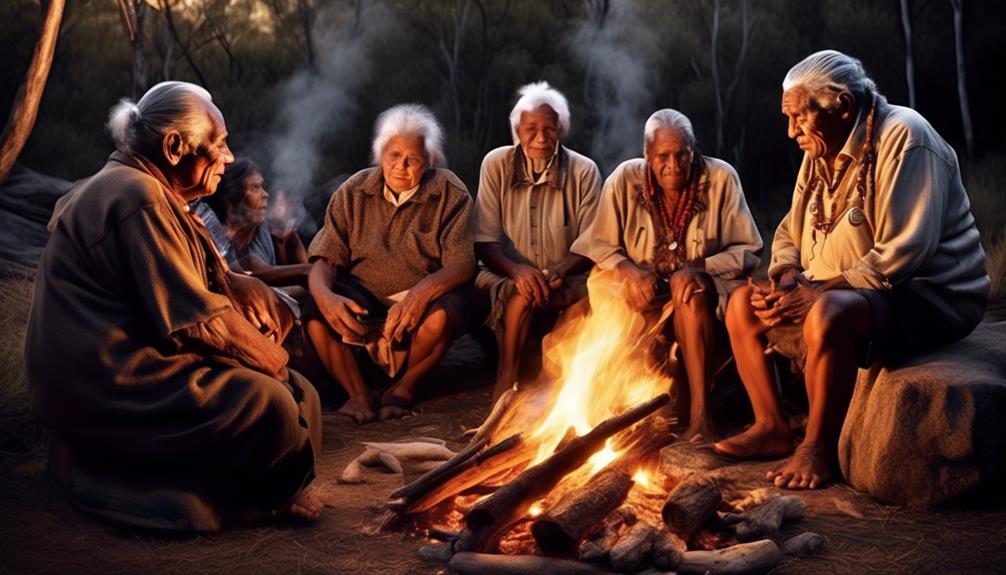
Drawing upon generations of shared experiences and knowledge, the Aboriginal population of Australia has preserved their rich history and cultural heritage through a tradition of oral storytelling. These storytelling traditions are deeply intertwined with spiritual beliefs, serving as a means to pass down knowledge, customs, and values from one generation to the next.
Within these narratives, ancestral connections, creation stories, and the natural world are interwoven, providing a comprehensive understanding of the Aboriginal people's cultural preservation and knowledge transmission.
The oral tradition holds immense significance within Aboriginal communities, as it embodies the collective wisdom and lived experiences of their ancestors. Through intricate storytelling, individuals learn about their origins, their ties to the land, and the spiritual forces that shape their worldview. These narratives aren't merely tales, but a repository of historical, environmental, and moral knowledge that serve as a guide for ethical conduct and decision-making.
Furthermore, the oral tradition plays a crucial role in sustaining cultural continuity and identity. By imparting essential knowledge about hunting, gathering, and land management, these stories ensure the transmission of vital survival skills and environmental awareness. Additionally, they reinforce the interconnectedness between the Aboriginal people and their ancestral lands, fostering a deep sense of belonging and responsibility.
In essence, the oral tradition is a fundamental mechanism for preserving the Aboriginal population's cultural legacy and ensuring the perpetuation of their profound spiritual beliefs and traditional knowledge.
Connection to Land and Environment
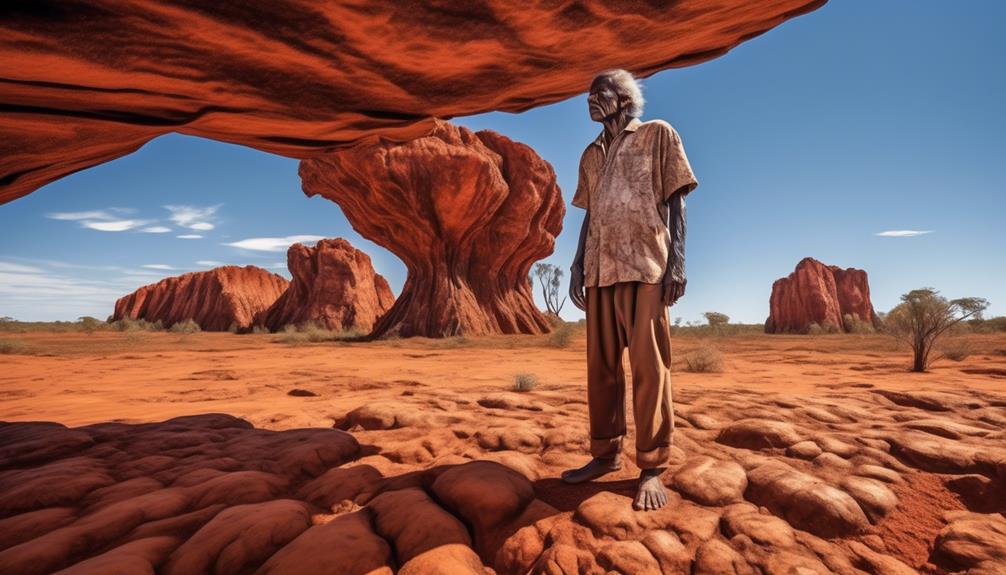
Our intricate relationship with the land and environment is woven into the very fabric of our cultural identity and spiritual beliefs. Our connection to nature isn't just physical, but deeply spiritual and intrinsic to our existence. Here are some key aspects that exemplify our profound connection to the land and environment:
- Dreaming Stories: Our spiritual beliefs are deeply intertwined with the land, as reflected in our Dreaming stories. These stories not only explain the creation of the land but also serve as a guide for how we should live in harmony with nature.
- Rituals and Ceremonies: Our rituals and ceremonies are intricately linked to the natural world. They serve as a way to honor the land, seek guidance from the spirits of nature, and ensure the balance and harmony of the environment.
- Kinship with the Land: We view the land as our ancestral mother, from whom we're born and to whom we return. This profound kinship with the land forms the basis of our identity and shapes our responsibilities to care for the environment.
- Environmental Stewardship: Our spiritual beliefs dictate that we're the custodians of the land. This responsibility drives our sustainable practices, ensuring that the land remains bountiful for generations to come.
Our connection to the land and environment isn't merely a physical one; it's the essence of our being, shaping our cultural practices, spiritual beliefs, and environmental stewardship.
Interactions With Other Cultures
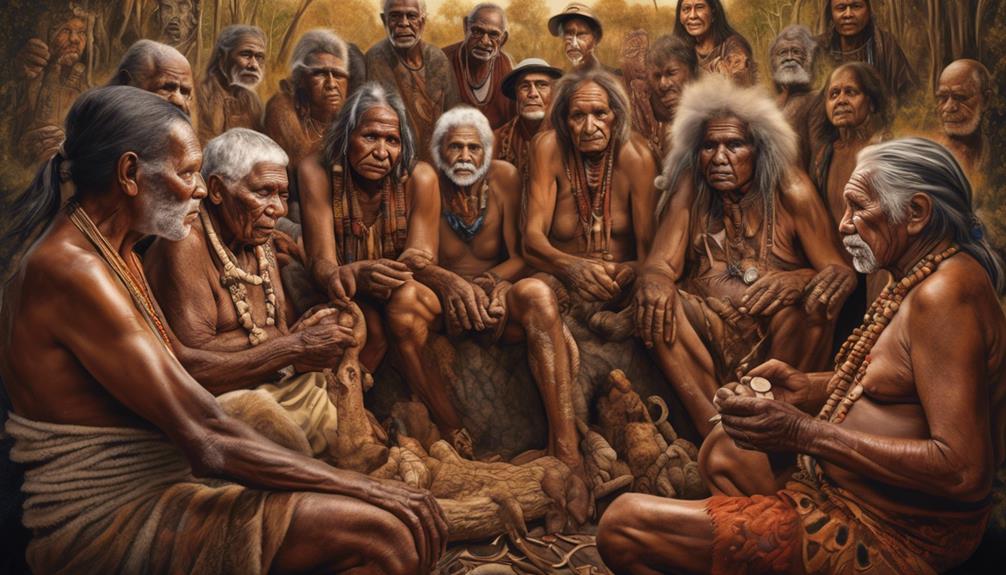
Our profound connection to the land and environment has shaped our interactions with other cultures, influencing the ways in which we engage and adapt to external influences while maintaining our cultural identity.
The history of Australia's Aboriginal population is marked by extensive cultural exchange and cross-cultural influences. Over millennia, interactions with other cultures, including the Macassans from present-day Indonesia, European explorers, and later British settlers, have significantly impacted our way of life. These encounters brought new technologies, foods, and languages, leading to a complex web of cross-cultural interactions that continue to shape our society today.
The Macassans, for instance, engaged in trade and cultural exchanges with Aboriginal communities in the northern parts of Australia, introducing metal tools, pottery, and different fishing techniques. This interaction not only influenced material culture but also had a profound impact on spiritual and social practices.
Similarly, the arrival of European explorers and later British settlers in the late 18th century brought about radical changes in our traditional lifestyle. The introduction of firearms, new diseases, and the displacement from our traditional lands significantly altered our social structures and cultural practices.
Despite these influences, our cultural identity has remained resilient. We've selectively adopted and adapted elements from other cultures while retaining our core beliefs and practices. The ongoing interactions with other cultures continue to shape our identity, creating a dynamic and evolving Aboriginal culture that's deeply rooted in the traditions of the past while embracing the opportunities and challenges of the present.
Genetic Studies and Findings
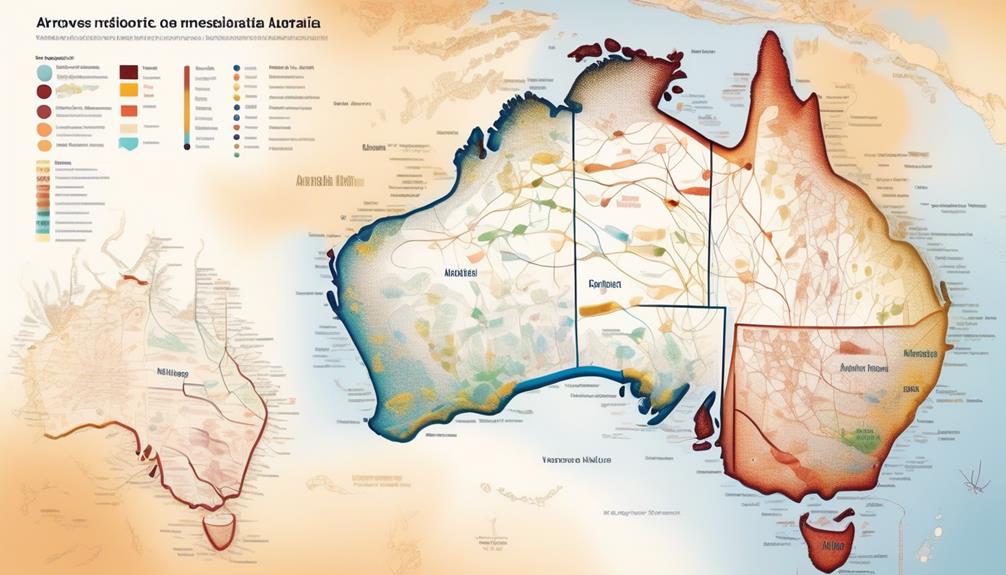
Genetic studies have provided valuable insights into the ancestral origins and population dynamics of Australia's Aboriginal people. Through the analysis of genetic diversity and population movements, researchers have made significant strides in understanding the complex history of Australia's Indigenous population.
- Genetic Diversity: Studies have revealed a high level of genetic diversity among Aboriginal Australians, indicating a long and rich history of population interactions and migrations within the continent. This diversity reflects the deep ancestral connections and the intricate web of relationships between different Aboriginal groups.
- Ancestral Origins: Genetic research has traced the origins of Australia's Aboriginal population to a single founding population that arrived on the continent tens of thousands of years ago. These findings align with the oral histories and cultural narratives of many Aboriginal communities, providing scientific validation to their enduring connection to the land.
- Population Movements: By analyzing the genetic signatures of different Aboriginal groups, scientists have been able to reconstruct ancient population movements across Australia. These studies have shed light on the ways in which different groups have interacted, migrated, and adapted to varying environmental conditions over millennia.
- Continued Research: Ongoing genetic research continues to uncover new insights into the origins and population dynamics of Aboriginal Australians. By integrating genetic data with archaeological and anthropological evidence, researchers are refining our understanding of Australia's rich Indigenous heritage.
Theories of Arrival
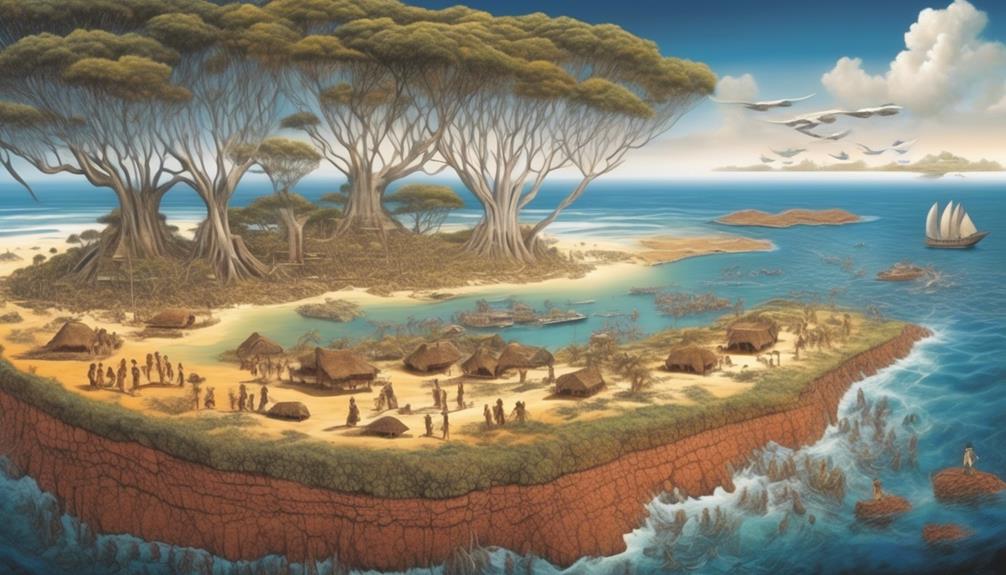
In examining the ancestral origins of Australia's Aboriginal population, various theories of arrival have been proposed to elucidate the early migration patterns and settlement processes of these Indigenous communities. Arrival theories encompass a range of hypotheses, including the 'Out of Africa' theory, which postulates that modern humans migrated from Africa to Australia around 75,000 years ago. Another prominent theory is the 'Southern Route' hypothesis, suggesting that early humans traveled along the coastline of the Indian Ocean, eventually reaching Australia. These theories are crucial in understanding the cultural significance and historical context of Aboriginal communities.
The cultural significance of arrival theories lies in their ability to connect present-day Aboriginal populations with their ancient ancestors. Understanding the pathways and timing of migration is essential for comprehending the development of different cultural practices, languages, and social structures within Aboriginal communities.
Furthermore, arrival theories provide a framework for exploring the genetic lineage and oral traditions of Aboriginal peoples, offering insights into their deep-rooted connections to the land and their ecological knowledge.
Impact on Modern Australia
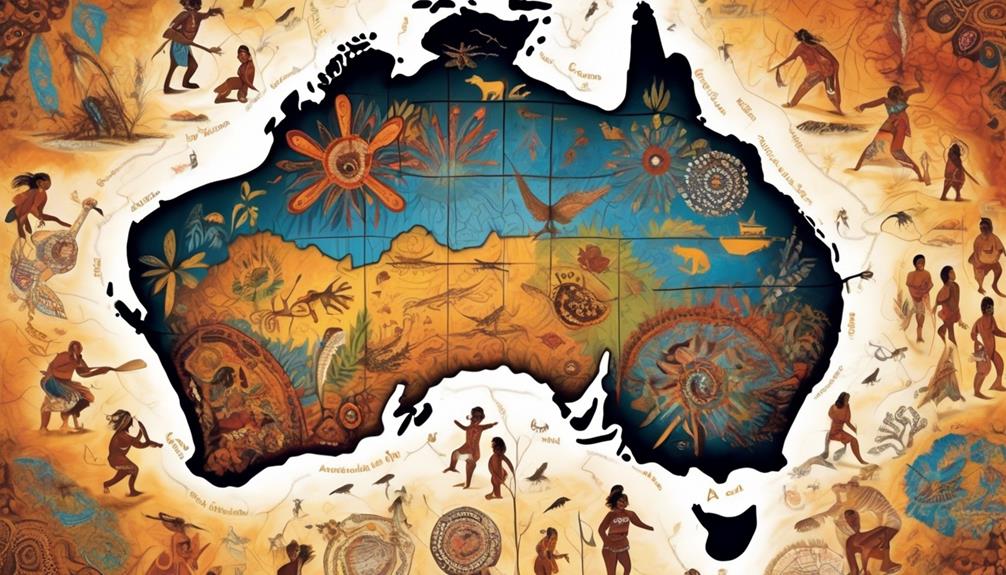
The enduring presence and cultural influence of Australia's Aboriginal population have significantly shaped the modern landscape, underscoring the complex interplay between traditional knowledge systems and contemporary societal dynamics.
The impact of the Aboriginal population on modern Australia is profound and multifaceted.
- Cultural Preservation: The preservation of Aboriginal cultural practices and traditions has enriched the diversity of Australian society, fostering greater understanding and appreciation of Indigenous heritage. Efforts to protect and promote Aboriginal languages, art, music, and storytelling have contributed to a more inclusive national identity.
- Impact on Society: The Aboriginal population's resilience and their ongoing struggle for recognition and rights have catalyzed important social and political changes. Movements for land rights, reconciliation, and the recognition of Indigenous sovereignty have brought attention to historical injustices and prompted national conversations about equality and justice.
- Economic Influence: The Aboriginal population's contributions to various industries, including art, tourism, and land management, have had a significant economic impact. Indigenous businesses and enterprises play a vital role in the Australian economy, contributing to the country's overall prosperity.
- Environmental Stewardship: Traditional Aboriginal ecological knowledge has influenced modern environmental conservation practices. Indigenous land management techniques and philosophies have contributed to sustainable resource use and biodiversity conservation.
The enduring influence of Australia's Aboriginal population on modern society underscores the importance of cultural preservation and the recognition of Indigenous rights in shaping a more inclusive and equitable nation.
Frequently Asked Questions
How Did the Ancient Aboriginal Population Interact With Other Cultures in the Region?
We engage in a cultural exchange through traditional practices, interacting with other cultures in the region. Our ancient aboriginal population interacted by sharing knowledge of land, resources, and spiritual beliefs.
This interaction facilitated the development of trade routes, artistic expressions, and social customs. The exchange of cultural practices allowed for the enrichment and diversity of our traditions, fostering a deep connection with neighboring communities.
What Are Some of the Theories About the Arrival of the Aboriginal Population in Australia?
Genetic studies have shed light on the migration patterns of Australia's Aboriginal population. Various theories have emerged, such as the 'Out of Africa' theory, suggesting a single migration wave, and the 'Southern Route' theory, proposing multiple waves.
These theories provide valuable insights into the complex history of Aboriginal population in Australia. Understanding their origins is crucial for appreciating the rich cultural heritage and deep-rooted connections to the land.
What Is the Impact of the Ancient Aboriginal Population on Modern Australia?
The impact of the ancient Aboriginal population on modern Australia is profound. Their cultural legacy is evident in art, language, and spirituality, shaping the national identity.
For instance, Aboriginal art has gained international recognition, contributing to the country's artistic prestige.
Their enduring connection to the land has influenced conservation efforts and sustainability practices.
Are There Any Genetic Studies and Findings That Shed Light on the Origins of the Aboriginal Population?
Genetic studies have shed light on the origins of the Aboriginal population, revealing a deep connection to the land.
These findings have had a significant impact on modern Australia, as they've contributed to a better understanding and appreciation of the rich cultural heritage of the Aboriginal people.
How Did the Ancient Aboriginal Population Perceive Their Connection to the Land and Environment?
Our ancient Aboriginal population had a deep, spiritual connection to the land, viewing it as sacred and integral to their identity. Their spiritual beliefs were intertwined with the land, guiding traditional practices and environmental stewardship.
This connection shaped their perception of the environment, leading to a profound understanding of their role as caretakers. Their intricate knowledge of the land and its resources reflected a harmonious relationship based on respect and reciprocity.
Conclusion
In conclusion, the origins of Australia's Aboriginal population are deeply rooted in ancient genetic lineage, migration patterns, archeological discoveries, oral traditions and stories, connection to land and environment, interactions with other cultures, and genetic studies and findings.
These factors have shaped the rich and diverse cultural heritage of the Aboriginal people, leaving a lasting impact on modern Australia.
Their history is a testament to resilience, adaptability, and a deep connection to the land and environment.
Mary is a passionate writer who brings creativity and a fresh perspective to our team. Her words have the power to captivate and inspire, making her an essential contributor to our content. Mary’s commitment to storytelling and dedication to promoting Indigenous culture ensures that her work touches the hearts of our readers. We’re fortunate to have her as part of our team.
